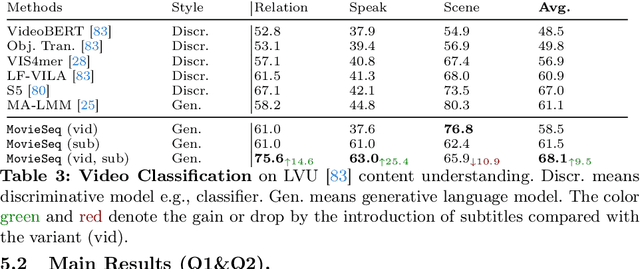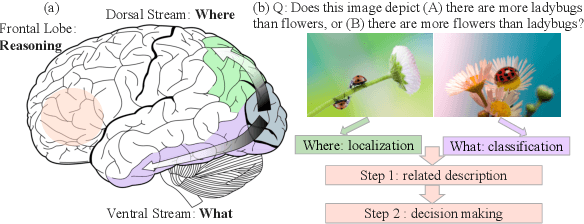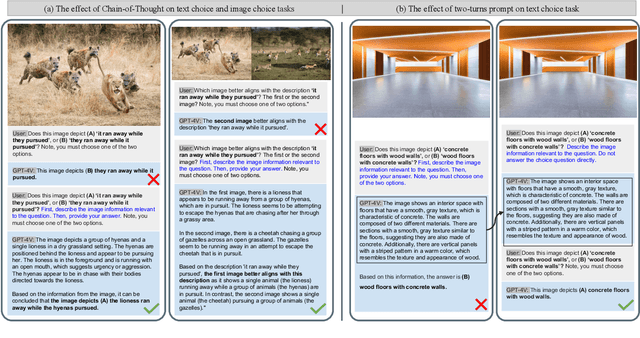Pengchuan Zhang
Jack
TLDR: Token-Level Detective Reward Model for Large Vision Language Models
Oct 07, 2024



Abstract:Although reward models have been successful in improving multimodal large language models, the reward models themselves remain brutal and contain minimal information. Notably, existing reward models only mimic human annotations by assigning only one binary feedback to any text, no matter how long the text is. In the realm of multimodal language models, where models are required to process both images and texts, a naive reward model may learn implicit biases toward texts and become less grounded in images. In this paper, we propose a $\textbf{T}$oken-$\textbf{L}$evel $\textbf{D}$etective $\textbf{R}$eward Model ($\textbf{TLDR}$) to provide fine-grained annotations to each text token. We first introduce a perturbation-based method to generate synthetic hard negatives and their token-level labels to train TLDR models. Then we show the rich usefulness of TLDR models both in assisting off-the-shelf models to self-correct their generations, and in serving as a hallucination evaluation tool. Finally, we show that TLDR models can significantly speed up human annotation by 3 times to acquire a broader range of high-quality vision language data.
The Llama 3 Herd of Models
Jul 31, 2024Abstract:Modern artificial intelligence (AI) systems are powered by foundation models. This paper presents a new set of foundation models, called Llama 3. It is a herd of language models that natively support multilinguality, coding, reasoning, and tool usage. Our largest model is a dense Transformer with 405B parameters and a context window of up to 128K tokens. This paper presents an extensive empirical evaluation of Llama 3. We find that Llama 3 delivers comparable quality to leading language models such as GPT-4 on a plethora of tasks. We publicly release Llama 3, including pre-trained and post-trained versions of the 405B parameter language model and our Llama Guard 3 model for input and output safety. The paper also presents the results of experiments in which we integrate image, video, and speech capabilities into Llama 3 via a compositional approach. We observe this approach performs competitively with the state-of-the-art on image, video, and speech recognition tasks. The resulting models are not yet being broadly released as they are still under development.
Learning Video Context as Interleaved Multimodal Sequences
Jul 31, 2024



Abstract:Narrative videos, such as movies, pose significant challenges in video understanding due to their rich contexts (characters, dialogues, storylines) and diverse demands (identify who, relationship, and reason). In this paper, we introduce MovieSeq, a multimodal language model developed to address the wide range of challenges in understanding video contexts. Our core idea is to represent videos as interleaved multimodal sequences (including images, plots, videos, and subtitles), either by linking external knowledge databases or using offline models (such as whisper for subtitles). Through instruction-tuning, this approach empowers the language model to interact with videos using interleaved multimodal instructions. For example, instead of solely relying on video as input, we jointly provide character photos alongside their names and dialogues, allowing the model to associate these elements and generate more comprehensive responses. To demonstrate its effectiveness, we validate MovieSeq's performance on six datasets (LVU, MAD, Movienet, CMD, TVC, MovieQA) across five settings (video classification, audio description, video-text retrieval, video captioning, and video question-answering). The code will be public at https://github.com/showlab/MovieSeq.
GenAI-Bench: Evaluating and Improving Compositional Text-to-Visual Generation
Jun 19, 2024



Abstract:While text-to-visual models now produce photo-realistic images and videos, they struggle with compositional text prompts involving attributes, relationships, and higher-order reasoning such as logic and comparison. In this work, we conduct an extensive human study on GenAI-Bench to evaluate the performance of leading image and video generation models in various aspects of compositional text-to-visual generation. We also compare automated evaluation metrics against our collected human ratings and find that VQAScore -- a metric measuring the likelihood that a VQA model views an image as accurately depicting the prompt -- significantly outperforms previous metrics such as CLIPScore. In addition, VQAScore can improve generation in a black-box manner (without finetuning) via simply ranking a few (3 to 9) candidate images. Ranking by VQAScore is 2x to 3x more effective than other scoring methods like PickScore, HPSv2, and ImageReward at improving human alignment ratings for DALL-E 3 and Stable Diffusion, especially on compositional prompts that require advanced visio-linguistic reasoning. We will release a new GenAI-Rank benchmark with over 40,000 human ratings to evaluate scoring metrics on ranking images generated from the same prompt. Lastly, we discuss promising areas for improvement in VQAScore, such as addressing fine-grained visual details. We will release all human ratings (over 80,000) to facilitate scientific benchmarking of both generative models and automated metrics.
BEHAVIOR Vision Suite: Customizable Dataset Generation via Simulation
May 15, 2024



Abstract:The systematic evaluation and understanding of computer vision models under varying conditions require large amounts of data with comprehensive and customized labels, which real-world vision datasets rarely satisfy. While current synthetic data generators offer a promising alternative, particularly for embodied AI tasks, they often fall short for computer vision tasks due to low asset and rendering quality, limited diversity, and unrealistic physical properties. We introduce the BEHAVIOR Vision Suite (BVS), a set of tools and assets to generate fully customized synthetic data for systematic evaluation of computer vision models, based on the newly developed embodied AI benchmark, BEHAVIOR-1K. BVS supports a large number of adjustable parameters at the scene level (e.g., lighting, object placement), the object level (e.g., joint configuration, attributes such as "filled" and "folded"), and the camera level (e.g., field of view, focal length). Researchers can arbitrarily vary these parameters during data generation to perform controlled experiments. We showcase three example application scenarios: systematically evaluating the robustness of models across different continuous axes of domain shift, evaluating scene understanding models on the same set of images, and training and evaluating simulation-to-real transfer for a novel vision task: unary and binary state prediction. Project website: https://behavior-vision-suite.github.io/
Evaluating Text-to-Visual Generation with Image-to-Text Generation
Apr 01, 2024



Abstract:Despite significant progress in generative AI, comprehensive evaluation remains challenging because of the lack of effective metrics and standardized benchmarks. For instance, the widely-used CLIPScore measures the alignment between a (generated) image and text prompt, but it fails to produce reliable scores for complex prompts involving compositions of objects, attributes, and relations. One reason is that text encoders of CLIP can notoriously act as a "bag of words", conflating prompts such as "the horse is eating the grass" with "the grass is eating the horse". To address this, we introduce the VQAScore, which uses a visual-question-answering (VQA) model to produce an alignment score by computing the probability of a "Yes" answer to a simple "Does this figure show '{text}'?" question. Though simpler than prior art, VQAScore computed with off-the-shelf models produces state-of-the-art results across many (8) image-text alignment benchmarks. We also compute VQAScore with an in-house model that follows best practices in the literature. For example, we use a bidirectional image-question encoder that allows image embeddings to depend on the question being asked (and vice versa). Our in-house model, CLIP-FlanT5, outperforms even the strongest baselines that make use of the proprietary GPT-4V. Interestingly, although we train with only images, VQAScore can also align text with video and 3D models. VQAScore allows researchers to benchmark text-to-visual generation using complex texts that capture the compositional structure of real-world prompts. We introduce GenAI-Bench, a more challenging benchmark with 1,600 compositional text prompts that require parsing scenes, objects, attributes, relationships, and high-order reasoning like comparison and logic. GenAI-Bench also offers over 15,000 human ratings for leading image and video generation models such as Stable Diffusion, DALL-E 3, and Gen2.
The Role of Chain-of-Thought in Complex Vision-Language Reasoning Task
Nov 15, 2023



Abstract:The study explores the effectiveness of the Chain-of-Thought approach, known for its proficiency in language tasks by breaking them down into sub-tasks and intermediate steps, in improving vision-language tasks that demand sophisticated perception and reasoning. We present the "Description then Decision" strategy, which is inspired by how humans process signals. This strategy significantly improves probing task performance by 50%, establishing the groundwork for future research on reasoning paradigms in complex vision-language tasks.
MiniGPT-v2: large language model as a unified interface for vision-language multi-task learning
Oct 26, 2023



Abstract:Large language models have shown their remarkable capabilities as a general interface for various language-related applications. Motivated by this, we target to build a unified interface for completing many vision-language tasks including image description, visual question answering, and visual grounding, among others. The challenge is to use a single model for performing diverse vision-language tasks effectively with simple multi-modal instructions. Towards this objective, we introduce MiniGPT-v2, a model that can be treated as a unified interface for better handling various vision-language tasks. We propose using unique identifiers for different tasks when training the model. These identifiers enable our model to better distinguish each task instruction effortlessly and also improve the model learning efficiency for each task. After the three-stage training, the experimental results show that MiniGPT-v2 achieves strong performance on many visual question-answering and visual grounding benchmarks compared to other vision-language generalist models. Our model and codes are available at https://minigpt-v2.github.io/
Revisiting Kernel Temporal Segmentation as an Adaptive Tokenizer for Long-form Video Understanding
Sep 20, 2023Abstract:While most modern video understanding models operate on short-range clips, real-world videos are often several minutes long with semantically consistent segments of variable length. A common approach to process long videos is applying a short-form video model over uniformly sampled clips of fixed temporal length and aggregating the outputs. This approach neglects the underlying nature of long videos since fixed-length clips are often redundant or uninformative. In this paper, we aim to provide a generic and adaptive sampling approach for long-form videos in lieu of the de facto uniform sampling. Viewing videos as semantically consistent segments, we formulate a task-agnostic, unsupervised, and scalable approach based on Kernel Temporal Segmentation (KTS) for sampling and tokenizing long videos. We evaluate our method on long-form video understanding tasks such as video classification and temporal action localization, showing consistent gains over existing approaches and achieving state-of-the-art performance on long-form video modeling.
UniVTG: Towards Unified Video-Language Temporal Grounding
Aug 18, 2023Abstract:Video Temporal Grounding (VTG), which aims to ground target clips from videos (such as consecutive intervals or disjoint shots) according to custom language queries (e.g., sentences or words), is key for video browsing on social media. Most methods in this direction develop taskspecific models that are trained with type-specific labels, such as moment retrieval (time interval) and highlight detection (worthiness curve), which limits their abilities to generalize to various VTG tasks and labels. In this paper, we propose to Unify the diverse VTG labels and tasks, dubbed UniVTG, along three directions: Firstly, we revisit a wide range of VTG labels and tasks and define a unified formulation. Based on this, we develop data annotation schemes to create scalable pseudo supervision. Secondly, we develop an effective and flexible grounding model capable of addressing each task and making full use of each label. Lastly, thanks to the unified framework, we are able to unlock temporal grounding pretraining from large-scale diverse labels and develop stronger grounding abilities e.g., zero-shot grounding. Extensive experiments on three tasks (moment retrieval, highlight detection and video summarization) across seven datasets (QVHighlights, Charades-STA, TACoS, Ego4D, YouTube Highlights, TVSum, and QFVS) demonstrate the effectiveness and flexibility of our proposed framework. The codes are available at https://github.com/showlab/UniVTG.
 Add to Chrome
Add to Chrome Add to Firefox
Add to Firefox Add to Edge
Add to Edge